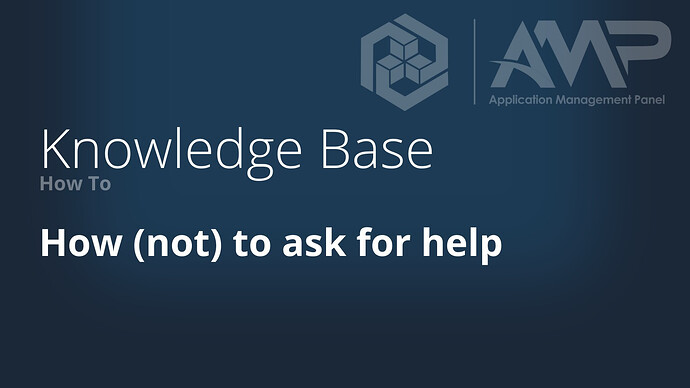If you need help with something, it’s important to give accurate and succinct information to make sure that whoever is helping you knows enough about the situation to make a quick assessment of the problem and to offer a solution.
Here are the most common mistakes people make when asking for help, what to avoid, and what you should do instead.
“Can anyone help?”
When you need assistance, start off with the question itself. Avoid asking vague questions and waiting for a response. Be specific and direct about what you’re having problems with rather than just asking for ‘help’.
Start with a polite introduction, explain your situation, and the problem at hand.
Bad Example:
Hi, is anyone around who can help me?
Good Example:
Hi everyone, I’m running AMP on Ubuntu 22.04 LTS. This is a brand new installation. When I try to manage a new instance after creating it, I get a message saying “Instance is not running”
“It doesn’t work” / “It’s broken”
Make sure you’re always accurate and descriptive with what the problem is. Talk more about what you’re expecting to happen v.s. what is actually happening.
Bad Example:
My SFTP doesn’t work
Good Example:
When I try to connect to SFTP, my client gives me a “Timed Out” error - I’m using AMP version 2.4.1.4 on Debian 11.
“Nothing Happened”
“Nothing” is undescriptive, and often inaccurate. Just because there was nothing to see does not mean that nothing happened. It doesn’t tell the person you’re talking to if something has stalled and is still waiting, or if a process has finished.
Bad Example:
I ran the command and nothing happened.
Good Example:
After running the command, there was no visible output in the console - and the shell immediately returned to a fresh prompt.
“I got a message about something”
When talking about error messages, always include the whole error message verbatim. Don’t paraphrase, shorten or summarise. Including the full message makes it easier for others to know exactly what you’re talking about and to search for solutions.
Bad Example:
I clicked manage and got some message about versions
Good Example:
I clicked manage and got the message “ADS is a newer version than this instance. ADS is version 2.4.3.0 but this instance is version 2.4.2.0. Please update this instance”
